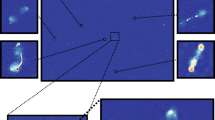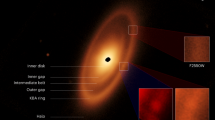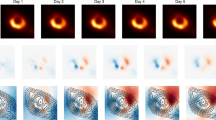Abstract
Neptune has a collection of incomplete narrow rings, known as ring arcs, which should in isolation be destroyed by differential motion in a matter of months. Yet since first discovered1 by stellar occultations in 1984, they appear to have persisted2,3,4,5,6, perhaps through a gravitational resonance effect involving the satellite Galatea6,7,8. Here we report ground-based observations of the ring arcs, obtained using an adaptive optics system. Our data, and those obtained using the Hubble Space Telescope (reported in a companion paper9), indicate that the ring arcs are near, but not within the resonance with Galatea, in contrast to what is predicted by some models.
This is a preview of subscription content, access via your institution
Access options
Subscribe to this journal
Receive 51 print issues and online access
$199.00 per year
only $3.90 per issue
Buy this article
- Purchase on Springer Link
- Instant access to full article PDF
Prices may be subject to local taxes which are calculated during checkout


Similar content being viewed by others
References
Hubbard, W. B., Brahic, A., Sicardy, B., Elicer, L. R. & Vilas, F. Occultation detection of a Neptunian ring-like arc. Nature 319, 636–640 (1986).
Sicardy, B., Roques, F. & Brahic, A. Neptune's rings, 1983–1989: Ground-based stellar occultations observations. Icarus 89, 220–243 (1991).
Nicholson, P. D., Mosqueira, I. & Matthews, K. Stellar occultation observations of Neptune's rings: 1984–1988. Icarus 113, 295–330 (1995).
Porco, C. C., Nicholson, P. D., Cuzzi, J. N., Lissauer, J. J. & Esposito, L. W. in Neptune and Triton (ed. Cruikshank, D. P.) 703–804 (Univ. Arizona Press, Tucson, (1995).
Smith, B. A. et al. Voyager 2 at Neptune: imaging science results. Science 246, 1422–1449 (1989).
Porco, C. C. An explanation for Neptune's ring arcs. Science 253, 995–1001 (1991).
Goldreich, P., Tremaine, S. & Borderies, N. Towards a theory for Neptune's arc rings. Astron. J. 92, 490–494 (1986).
Horanyi, M. & Porco, C. C. Where exactly are the arcs of Neptune? Icarus 106, 225–235 (1993).
Dumas, C., Terrile, R. J., Smith, B. A., Schneider, G. H. & Becklin, E. E. Stability of Neptune's ring arcs in question. Nature 400, 733–735 (1999).
Owen, W. M. J, Vaughan, R. M. & Synnott, S. P. Orbits of the six new satellites of Neptune. Astron. J. 101, 1511–1515 (1991).
Roddier, C. et al. Satellites and rings of Neptune. IAU Circ.No. 7051(1998).
Foryta, D. W. & Sicardy, B. The dynamics of the Neptunian Adams ring's arcs. Icarus 123, 129–167 (1996).
Lissauer, J. J. Shepherding model for Neptune's arc ring. Nature 318, 544–545 (1985).
Hänninen, J. & Porco, C. Collisional simulations of Neptune's ring arcs. Icarus 126, 1–27 (1997).
Graves, J. E., Northcott, M., Roddier, F., Roddier, C. & Close, L. First light for Hokupa'a, 36-element curvature optics system at UH. Proc. SPIE 3353, 34–43 (1998).
Roddier, F., Northcott, M. & Graves, J. E. Asimple low-order adaptive optics system for near-infrared applications. Publ. Astron. Soc. Pacif. 103, 131–149 (1991).
Roddier, F. Curvature sensing and compensation: a new concept in adaptive optics. Appl. Opt. 27, 1223–1225 (1988).
Roddier, C. et al. Rings of Neptune. IAU Circ.No. 7108(1999).
Jacobson, R. A., Riedel, J. E. & Taylor, A. H. The orbits of Triton and Nereid from spacecraft and earthbased observations. Astron. Astrophys. 247, 565–575 (1991).
Acknowledgements
The work of E.P. at DESPA is supported by the G. Colombo research fellowship of the European Space Agency. Adaptive optics observations of Neptune at the University of Hawaii were supported by NASA.
Author information
Authors and Affiliations
Corresponding author
Rights and permissions
About this article
Cite this article
Sicardy, B., Roddier, F., Roddier, C. et al. Images of Neptune's ring arcs obtained by a ground-based telescope. Nature 400, 731–733 (1999). https://doi.org/10.1038/23410
Received:
Accepted:
Issue Date:
DOI: https://doi.org/10.1038/23410
This article is cited by
-
Coupling between corotation and Lindblad resonances in the presence of secular precession rates
Celestial Mechanics and Dynamical Astronomy (2014)
-
Phase-space volume of regions of trapped motion: multiple ring components and arcs
Celestial Mechanics and Dynamical Astronomy (2009)
-
Dynamics and Composition of Rings
Space Science Reviews (2005)
-
The confinement of Neptune's ring arcs by the moon Galatea
Nature (2002)
-
Stability of Neptune's ring arcs in question
Nature (1999)
Comments
By submitting a comment you agree to abide by our Terms and Community Guidelines. If you find something abusive or that does not comply with our terms or guidelines please flag it as inappropriate.



